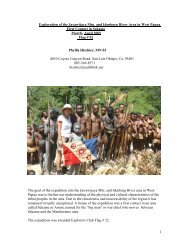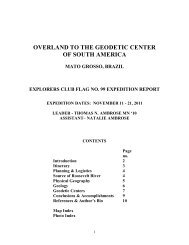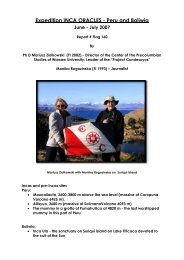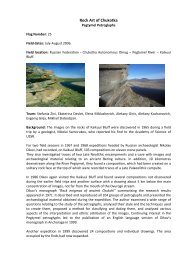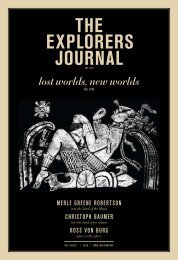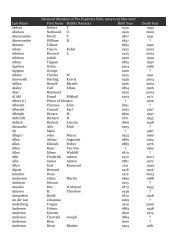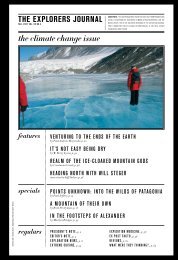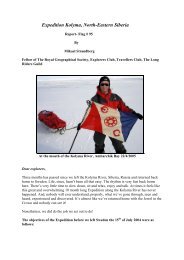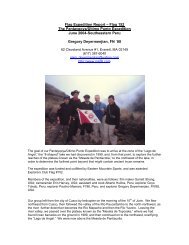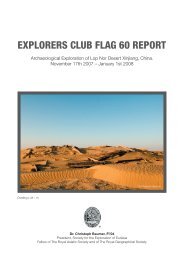the explorers journal the global adventure issue - The Explorers Club
the explorers journal the global adventure issue - The Explorers Club
the explorers journal the global adventure issue - The Explorers Club
- No tags were found...
You also want an ePaper? Increase the reach of your titles
YUMPU automatically turns print PDFs into web optimized ePapers that Google loves.
seabirds such as Cape Petrels were more abundant around icebergs than in <strong>the</strong> open waters of <strong>the</strong> Weddell Sea. <strong>The</strong> waterfall behind <strong>the</strong>m is meltwater from <strong>the</strong> iceberg, which nourishes its surrounding waters .Delighted with our findings, I asked colleaguesinterested in icebergs if <strong>the</strong>y would be willing tolaunch a multidisciplinary study of <strong>the</strong>se driftingislands in <strong>the</strong> Sou<strong>the</strong>rn Ocean. <strong>The</strong> scientificreviewers of my grant proposals, however, werenot convinced that icebergs could influence <strong>the</strong>pelagic ecosystem. Despite my enthusiasm for <strong>the</strong>research project, it failed to generate any significantinterest. Eventually, we succeeded in obtaininga small grant for exploratory research from <strong>the</strong>National Science Foundation (NSF) for a modest,month-long research expeditionto <strong>the</strong> WeddellSea. Our team of sevenconsisted of BruceRobison (Monterey BayAquarium ResearchInstitute), who wouldstudy <strong>the</strong> communityof organisms under<strong>the</strong>ice surface; MariaVernet (University ofCalifornia, San Diego),who would study <strong>the</strong>phytoplankton; RonKaufmann (Universityof San Diego), whowould study <strong>the</strong> macrozooplanktonandmicronekton; Tim Shaw(University of South Carolina), who would study<strong>the</strong> detrital material associated with <strong>the</strong> icebergs;John Helly (UCSD), who would study icebergstructure and assess iceberg populations fromsatellite imagery; and Robert Wilson (UCSD) andHenry Ruhl (MBARI), who would study seabirds.On November 27, 2005, our group departedfrom Punta Arenas, at <strong>the</strong> sou<strong>the</strong>rn tip of Chile,aboard <strong>the</strong> RV L. M. Gould, a 76-meter researchship with an orange ice-streng<strong>the</strong>ned hull. Onboard were laboratories and expansive deckspace to conduct over-<strong>the</strong>-side sampling. <strong>The</strong>ship was outfitted with a large multiple openingclosingtrawl system and a CTD, a device thatcould be lowered into <strong>the</strong> water to record salinityand temperature with depth, and a variety of watersamplers. A remotely operated underwater vehicle(ROV) was also on board for observing andsampling under <strong>the</strong> icebergs. Over <strong>the</strong> course ofa month, we were able to study two free-driftingicebergs in <strong>the</strong> Weddell Sea.<strong>The</strong> smaller iceberg was approximately twokilometers long and 41 meters high, with a submergeddepth greater than 300 meters. To documentchanges in flora and fauna associated with<strong>the</strong> iceberg, we put <strong>the</strong> ship on a spiral track thatbegan at 20 meters out from <strong>the</strong> island of ice. We<strong>the</strong>n began circling it, taking samples at ever-increasingdistances from it up to nine kilometers.<strong>The</strong> second iceberg was some 21 kilometerslong and 30 meters high, with a submerged depthof more than 230 meters. This iceberg was far toolarge for us to embarkon <strong>the</strong> spiral samplingused on <strong>the</strong> smallerone, so we put <strong>the</strong> shipon a course of paralleltransects along eachlength of <strong>the</strong> iceberg,out to a distance ofnine kilometers.As <strong>the</strong> icebergsslowly melt, <strong>the</strong>y shediron-rich terrigenousmaterial, likely pickedup as wind-blowndust and from glaciallyground bedrock when<strong>the</strong> ice was forming.Nutrients from thisterrigenous materialincreased phytoplankton growth in <strong>the</strong> vicinity of<strong>the</strong> iceberg. Elevated concentrations of phytoplankton,being at <strong>the</strong> base of <strong>the</strong> pelagic foodchain, in turn nourished <strong>the</strong> zooplankton (krill)around <strong>the</strong> iceberg, which were significantly increasedin number compared to more peripheralwaters. <strong>The</strong> highest level of <strong>the</strong> food web, <strong>the</strong> seabirds—dominatedby Cape petrels and Antarcticfulmars—were also substantially higher in numberaround <strong>the</strong> iceberg, feeding on <strong>the</strong> abundant krill.Watching <strong>the</strong> real-time video from <strong>the</strong> ROV,secured to <strong>the</strong> ship with a 300-meter electromechanicalte<strong>the</strong>r, we observed something quiteunexpected—extensive “fields” of attached algae(diatoms) growing on small fragments of volcanicrock embedded in <strong>the</strong> surface of <strong>the</strong> submergedice. <strong>The</strong>se algae bloomed where down-wellinglight was sufficient for growth to depths as deepas 60 meters. We also saw swarms of krill ando<strong>the</strong>r zooplankton associated with crevasses andoutcrops on <strong>the</strong> undersurface of <strong>the</strong> ice.<strong>the</strong> <strong>explorers</strong> <strong>journal</strong>



